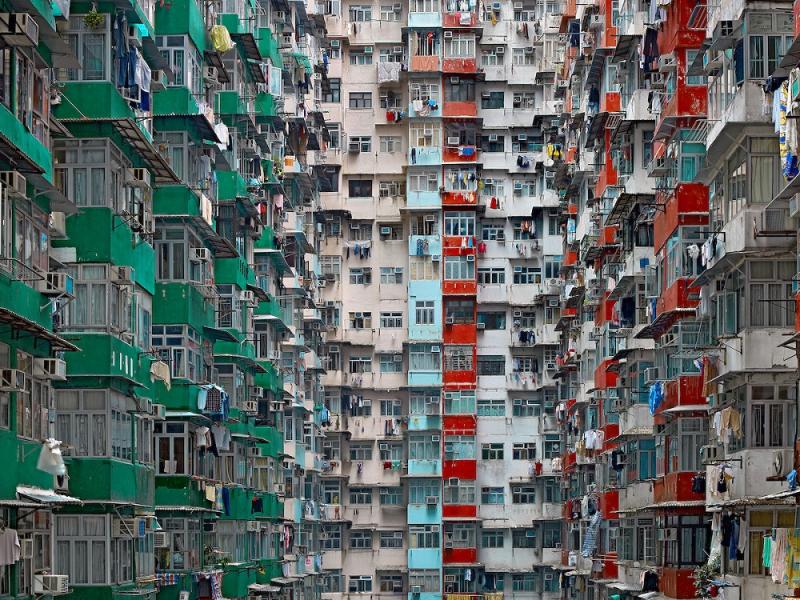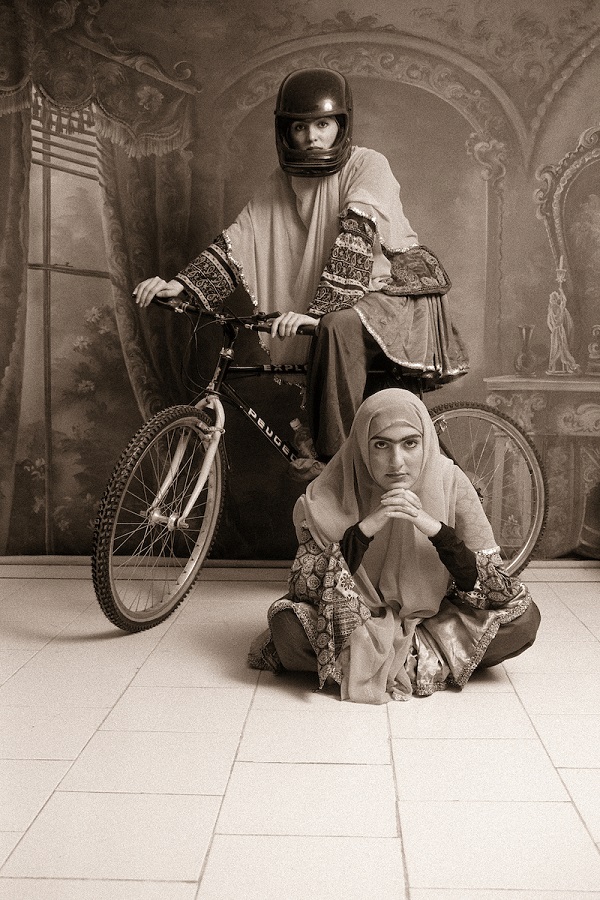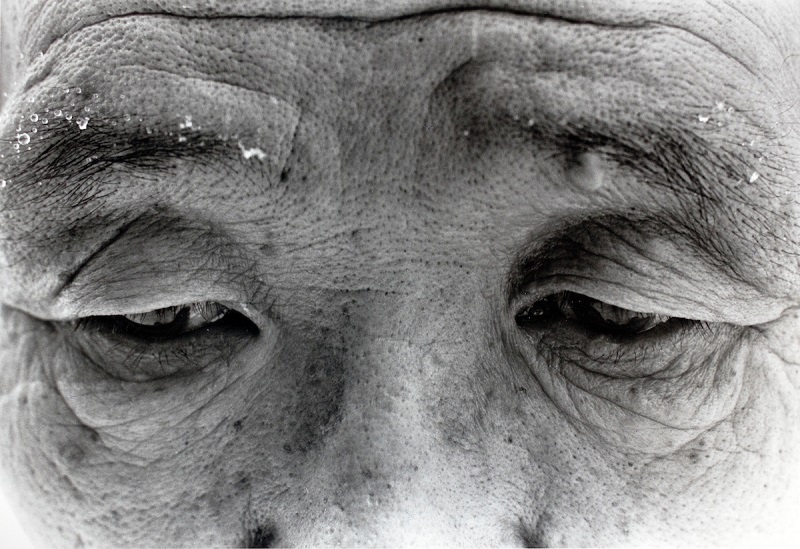theartsdesk at Les Rencontres d'Arles: breadth and depth at the veteran photo festival | reviews, news & interviews
theartsdesk at Les Rencontres d'Arles: breadth and depth at the veteran photo festival
theartsdesk at Les Rencontres d'Arles: breadth and depth at the veteran photo festival
The world in focus at inspirational annual photography event

Now in its 48th year the veteran photography festival is in better shape than ever. You can walk through the French sunshine to more than 20 exhibitions, hear a talk, meet the snappers and shop on the fringe.
Their images give an unmediated view of their lives and troubles - Colombian women staring down the camera "like men"; sad pictures of remembrance from Iran (pictured right: Shadi Ghadirian, Qajar, 1998). Some pictures are truly shocking. Here, for example, are Iranian men and women photographing an execution on their mobile phones. And from other far-off countries there are wonderful images from Chile by Paz Erràzuriz showing the undocumented people of a repressed society, Marie Bovo’s snaps through the doors of the Polish and Russian railways and a major exhibition of Latin American photography.
 Michael Wolf’s Life in the Cities was the highpoint for me, in every sense. The camera zooms in from huge, beautifully detailed images of tower blocks in Hong Kong and Chicago to invade the privacy of those who live and work there (main picture). The show charts Wolf’s development from his early intimate images of life in a small German coalmining town to the alienation of the modern city - a journey in which the viewer progresses from involvement to surveillance and which ends, logically enough, with Google Street View. Some truly beautiful images of the rooftops of Paris are thrown in along the way, together with a huge installation of toys "made in China" surrounding images of the workers who made them.
Michael Wolf’s Life in the Cities was the highpoint for me, in every sense. The camera zooms in from huge, beautifully detailed images of tower blocks in Hong Kong and Chicago to invade the privacy of those who live and work there (main picture). The show charts Wolf’s development from his early intimate images of life in a small German coalmining town to the alienation of the modern city - a journey in which the viewer progresses from involvement to surveillance and which ends, logically enough, with Google Street View. Some truly beautiful images of the rooftops of Paris are thrown in along the way, together with a huge installation of toys "made in China" surrounding images of the workers who made them.
Henri Cartier-Bresson said that your first 10,000 photographs are your worst. Annie Leibovitz shows us 3,000 of hers – reportage from the Seventies and Eighties. Here are black and white 35mm shots of the Rolling Stones and the Beatles and Nixon, McGovern, Carter and Kissinger. The iconic images leap from the walls – Jagger in the lift in a bathrobe, Schwarzenegger’s bum – but mostly this is photojournalism and the interest lies in the events the pictures show. This was the long road to the high-grade commercial images of today’s Vanity Fair, but maybe the mid-point was the time to celebrate. When Leibovitz took up portraiture in the Eighties she produced some famous pictures: Meryl Streep pulling at her face, Whoopi Goldberg in a bath of milk and, of course, John Lennon naked on the bed with Yoko Ono shortly before he was shot. It is a pleasure, and something of a relief, to see them.
Another American, Joel Meyerowitz, shows some of his early street photography; acutely observed, mostly rather grim images – do we really live like that? From Japanese photographer Masahisa Fukase come early selfies (pictured below: Masahisa Fukase, Memories of Father), an obsession with ravens and an important series of images made in collaboration with his cat. In addition there are some profoundly moving family photographs featuring his ageing father and his nude wife. And so much more. A polemic against Monsanto, a 90-foot-long lightbox showing linked landscapes by Peter Fischli and David Weiss; gay men from Switzerland and Levittown from France, and so on. And it's not all one way. If you look too closely at some portraits you get snapped by a smartphone mounted above and, as happened to your reviewer, asked to sign a model release in French.
And so much more. A polemic against Monsanto, a 90-foot-long lightbox showing linked landscapes by Peter Fischli and David Weiss; gay men from Switzerland and Levittown from France, and so on. And it's not all one way. If you look too closely at some portraits you get snapped by a smartphone mounted above and, as happened to your reviewer, asked to sign a model release in French.
If you think you know what photography is and what the camera can do, a trip to Arles might convince you that you are wrong. The breadth and depth of this well-organised festival is an inspiration for photographers and curators everywhere. In the queue for my canteen lunch I met a woman from Ukraine who is organising a photographic festival there. Perhaps I can report to you next year from Odessa.
rating
Explore topics
Share this article
The future of Arts Journalism
You can stop theartsdesk.com closing!
We urgently need financing to survive. Our fundraising drive has thus far raised £49,000 but we need to reach £100,000 or we will be forced to close. Please contribute here: https://gofund.me/c3f6033d
And if you can forward this information to anyone who might assist, we’d be grateful.

Subscribe to theartsdesk.com
Thank you for continuing to read our work on theartsdesk.com. For unlimited access to every article in its entirety, including our archive of more than 15,000 pieces, we're asking for £5 per month or £40 per year. We feel it's a very good deal, and hope you do too.
To take a subscription now simply click here.
And if you're looking for that extra gift for a friend or family member, why not treat them to a theartsdesk.com gift subscription?
more Visual arts
 'We are bowled over!' Thank you for your messages of love and support
Much-appreciated words of commendation from readers and the cultural community
'We are bowled over!' Thank you for your messages of love and support
Much-appreciated words of commendation from readers and the cultural community
 Photo Oxford 2025 review - photography all over the town
At last, a UK festival that takes photography seriously
Photo Oxford 2025 review - photography all over the town
At last, a UK festival that takes photography seriously
![SEX MONEY RACE RELIGION [2016] by Gilbert and George. Installation shot of Gilbert & George 21ST CENTURY PICTURES Hayward Gallery](https://theartsdesk.com/sites/default/files/styles/thumbnail/public/mastimages/Gilbert%20%26%20George_%2021ST%20CENTURY%20PICTURES.%20SEX%20MONEY%20RACE%20RELIGION%20%5B2016%5D.%20Photo_%20Mark%20Blower.%20Courtesy%20of%20the%20Gilbert%20%26%20George%20and%20the%20Hayward%20Gallery._0.jpg?itok=7tVsLyR-) Gilbert & George, 21st Century Pictures, Hayward Gallery review - brash, bright and not so beautiful
The couple's coloured photomontages shout louder than ever, causing sensory overload
Gilbert & George, 21st Century Pictures, Hayward Gallery review - brash, bright and not so beautiful
The couple's coloured photomontages shout louder than ever, causing sensory overload
 Lee Miller, Tate Britain review - an extraordinary career that remains an enigma
Fashion photographer, artist or war reporter; will the real Lee Miller please step forward?
Lee Miller, Tate Britain review - an extraordinary career that remains an enigma
Fashion photographer, artist or war reporter; will the real Lee Miller please step forward?
 Kerry James Marshall: The Histories, Royal Academy review - a triumphant celebration of blackness
Room after room of glorious paintings
Kerry James Marshall: The Histories, Royal Academy review - a triumphant celebration of blackness
Room after room of glorious paintings
 Folkestone Triennial 2025 - landscape, seascape, art lovers' escape
Locally rooted festival brings home many but not all global concerns
Folkestone Triennial 2025 - landscape, seascape, art lovers' escape
Locally rooted festival brings home many but not all global concerns
 Sir Brian Clarke (1953-2025) - a personal tribute
Remembering an artist with a gift for the transcendent
Sir Brian Clarke (1953-2025) - a personal tribute
Remembering an artist with a gift for the transcendent
 Emily Kam Kngwarray, Tate Modern review - glimpses of another world
Pictures that are an affirmation of belonging
Emily Kam Kngwarray, Tate Modern review - glimpses of another world
Pictures that are an affirmation of belonging
 Kiefer / Van Gogh, Royal Academy review - a pairing of opposites
Small scale intensity meets large scale melodrama
Kiefer / Van Gogh, Royal Academy review - a pairing of opposites
Small scale intensity meets large scale melodrama
 Jenny Saville: The Anatomy of Painting, National Portrait Gallery review - a protégé losing her way
A brilliant painter in search of a worthwhile subject
Jenny Saville: The Anatomy of Painting, National Portrait Gallery review - a protégé losing her way
A brilliant painter in search of a worthwhile subject
 Abstract Erotic, Courtauld Gallery review - sculpture that is sensuous, funny and subversive
Testing the boundaries of good taste, and winning
Abstract Erotic, Courtauld Gallery review - sculpture that is sensuous, funny and subversive
Testing the boundaries of good taste, and winning
 Edward Burra, Tate Britain review - watercolour made mainstream
Social satire with a nasty bite
Edward Burra, Tate Britain review - watercolour made mainstream
Social satire with a nasty bite

Add comment